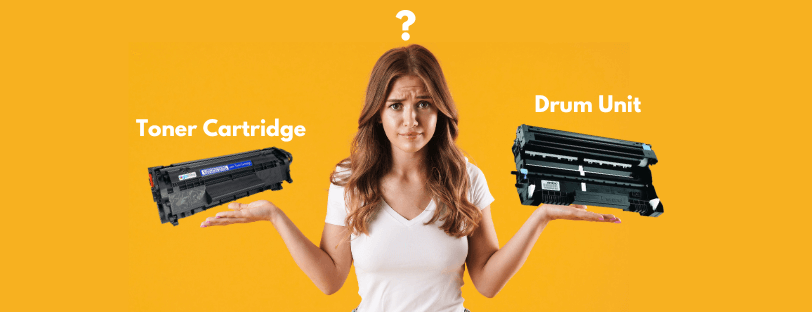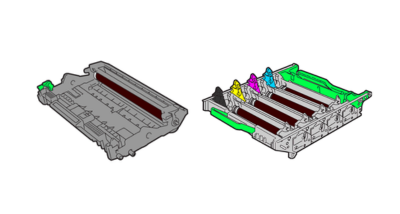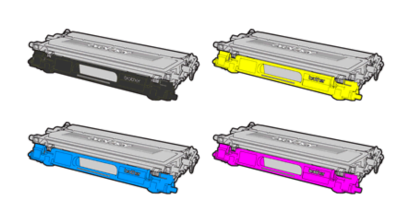
In the world of printing, two of the most important components that work together to produce high-quality prints are the drum and toner. Although these two work in conjunction with one another, they are distinct and serve different purposes.
Whilst the differences and benefits between a drum and toner may not be apparent at first glance, once you understand these two printer consumables a little better, it will make sense why their replacement and maintenance are essential.
In this blog post, we’ll delve into the specifics of drum units and toners, shedding light on their distinct roles and how they work together to deliver impressive print results.
What Is A Drum Unit?
 The drum unit, an essential part of every laser printer, functions as an electrically-charged cylinder responsible for transferring the stored toner powder from the cartridge onto the paper. When exposed to a laser or LED light source, the drum forms an electrostatic image of the content to be printed.
The drum unit, an essential part of every laser printer, functions as an electrically-charged cylinder responsible for transferring the stored toner powder from the cartridge onto the paper. When exposed to a laser or LED light source, the drum forms an electrostatic image of the content to be printed.
There are primarily two types of drum units commonly used in printers:
1. Integrated Drum Unit: An integrated drum unit combines the drum and the toner cartridge into a single unit. This type of drum unit is typically found in entry-level laser printers or all-in-one devices.
2. Separate Drum Unit: High-end laser printers often have separate drum units, consisting of an individual drum and toner cartridge. Typically, the drum unit lasts longer than the toner cartridge, so it only needs replacement when the drum wears out or malfunctions.
What Is A Toner Cartridge?

Toners, on the other hand, are responsible for the actual color or black-and-white pigmentation of the prints. They contain a powdered mixture of pigments, plastic particles, and other components that determine the color and quality of the prints.
When the printer receives a print command, the toner cartridge releases toner particles onto the developer roller, which then transfers the toner onto the drum unit. The drum unit, in turn, transfers the toner onto the paper to create the desired text or image.
When the toner inside a toner cartridge is fully used or depleted, it is necessary to replace the cartridge with a new one. Toner cartridges are designed to facilitate easy replacement once their toner content is exhausted or running out.
Differences Between A Drum And A Toner
Generally, modern laser printers contain both the drum and toner components, while some printers integrate the toner and drum within a single unit.
One of the benefits of having a separate drum unit and toner cartridge is being able to replace the components individually if your toner runs out or the drum unit becomes damaged. However, if the two components are housed together and one or the other needs replacing then the whole unit will need replacing.
While the drum and toner work together to create a printed page, they are different components with distinct roles in the printing process. Here are some of the key differences between a drum unit and a toner cartridge:
Drum Unit
- Function: Creates the electrostatic image of the content to be printed on the paper.
- Durability: Typically, a drum lasts longer than a toner cartridge and requires replacement after printing thousands of prints.
- Cost: In general, toner cartridges have a higher cost compared to drums. This is due to the more frequent replacement required for toner cartridges.
- Replacement: Drums and toner cartridges are typically sold separately and need to be replaced independently of each other. When replacing the toner cartridge, it’s important to ensure that the drum is in good condition, as a worn or damaged drum can impact the quality of the final print.
Toner Cartridge
- Function: Holds the toner powder that is used to create the final image or text on the paper.
- Durability: On the other hand, the replacement frequency of a toner cartridge depends on the printer usage.
- Cost: In general, toner cartridges are more expensive than drums. This is due to the more frequent replacement required for toner cartridges.
- Replacement: Drums and toner cartridges are sold separately and should be replaced independently. When replacing the toner cartridge, check the drum’s condition, as a worn or damaged drum can affect print quality.
When Do You Replace A Toner Cartridge And A Drum Unit?
Toner cartridges and drum units are vital components of laser printers and photocopiers. Although both contribute to the printing process, they serve different functions and have distinct replacement criteria. Here is a general guideline for replacing a toner cartridge and a drum unit:
Toner Cartridge:
-
- Replace the toner cartridge when the printer displays a low toner warning or when the print quality deteriorates significantly.
- Some printers may provide an estimate of the remaining toner level.
- If the toner cartridge is leaking or damaged, it should be replaced immediately.
Drum Unit:
-
- Replace the drum unit if print quality issues persist after replacing the toner cartridge.
- Signs of a failing drum unit include streaks, spots, and smudges on printed pages.
- The printer may also display an error message or warning indicating a problem with the drum unit.
- Replace the drum unit once you reach the manufacturer’s recommended maximum page count, regardless of any visible print quality issues.
Can You Buy A Drum And A Toner Together?
Yes, it is possible to purchase a drum and toner together as a combined unit for some printer models. Some printer models offer these combined units, which are sometimes called “drum units” or “imaging units.”
In laser printers, some models have a single cartridge for both the drum and toner. But in certain machines, these units are separate. This means you can replace the toner or the printer image unit individually, without having to replace the entire unit.
Need Help or More Information ?
If you need any further help or more information, reach out to us by leaving a comment below or through one of the many ways on our Contact Us page. Alternatively you can contact us by Phone on 0161 308 5800 or by Live Chat on our main Website Monday to Friday and our team will be happy to help or answer with any questions you might have. You can also find all the various ways to connect with Us at the bottom of this page. Please share this post if you found it helpful.

